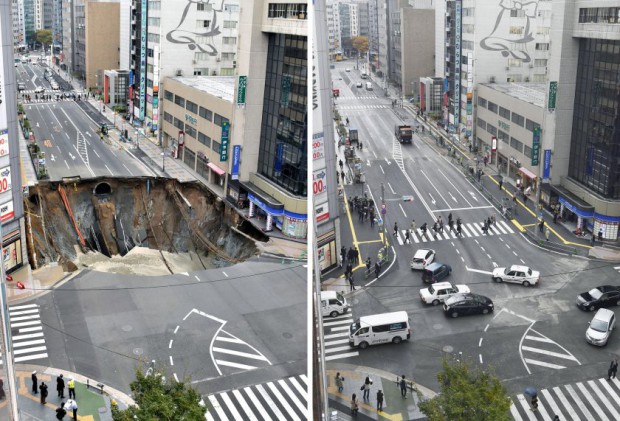Home > Blog > Global News
A Week of Global Disasters

Disasters strike like thieves in the night, unpredictable and dangerous. In a span of six days, they’ve wreaked havoc in different parts of the world, including the Philippines.
Sinkhole in Downtown Fukuoka
On November 8, a giant sinkhole ripped a busy road in the southwestern stretch of Fukuoka, Southern Japan. The 15-meter-deep sinkhole spanned 30 meters—
roughly half the size of an Olympic swimming pool. Though not a single person was injured, it caused interruptions in water, power, telecommunications and gas supply in some parts of the city. Residents speculated that the nearby subway construction might have triggered the slumping of the 5-lane thoroughway, but civil engineering experts attributed it to the soil’s composition, which is mostly sand.

Japan proved its efficiency in crisis management as sewage pipes and utility lines in the business district were restored in just two days. Nearly a week later, the collapsed road was repaired with a mixture of sand and cement, making it 30 times stronger than it used to be. On November 15, pedestrians and vehicles started using the re-opened street.
Quake in New Zealand
On November 13, a powerful 7.8 magnitude quake hit New Zealand’s South Island—the strongest in the region since 1929. Tsunamis towering up to 8 feet followed minutes after the groundshaking. These inundated communities in Kaikoura, a coastal town near the city of Christchurch. “This is the highest tsunami wave that New Zealand has seen in at least 38 years,” said Weather Watch New Zealand. According to experts, the tsunamis could have been more catastrophic if these transpired during high tide. Luckily, tide level was low at that time.
Apart from homes, livelihoods, office buildings and transport routes reduced to rubble, two fatalities in Canterbury were also reported. “In the short term, what we’re trying to do is to make sure that people of Kaikoura and the like have food, water, help and backup,” NZ Prime Minister John Key said.

No less than 40 aftershocks were recorded, but the strongest was a magnitude 6.2, which occurred a few hours after the major quake.
The 2016 Kaikoura quake has less death tolls than the massive 6.3 magnitude quake that struck Christchurch in 2011, causing 185 fatalities.
An average of 15,000 quakes per year are recorded in New Zealand, but about 150 are strong enough to be felt. The country is situated in the Pacific Ring of Fire, a horseshoe-shaped region where the most number of quakes and volcanic activities transpire.
On the same day, a 6.2 magnitude quake rocked Northwestern Argentina. The epicenter was recorded in the La Rioja province, but tremors were also felt in Catamarca, Tucuman, and Cordoba. However, these caused no damage and injuries.
Know how to prepare for huge quakes:
Volcano Erupts in Mexico
Western Mexico’s Colima Volcano, also known as the Volcano of Fire displayed unusual seismic activities, which prompted the evacuation of hundreds of people earlier this year. After a few months, this volcano erupted, forcing similar evacuations last October.
But last November 15, Tuesday, the abnormal activity of the volcano slowly increased as the new lava dome in its summit crater continued to grow. Its lava flow, rock fall, glowing avalanches and ash fall posed a threat to locals.

Colima Volcano has an elevation of nearly 4,000 meters with a 5-kilometer-wide crater mouth. 30 eruptions have been recorded in the past 431 years. It is considered one of the most active and dangerous volcanoes in Central America.
Know how to prepare for volcanic eruptions:
Mandaluyong faces State of Calamity
Three people died as 500 houses were burned down in an 8-hour blaze in Mandaluyong City on November 13, at around 7:45 pm. The fire consumed sections of two densely populated and fire-prone barangays. The Bureau of Fire Protection traced the cause to a leaking gas tank, and estimated property loss at 10 million pesos.

1,465 families from Barangays Addition Hills and San Jose were left homeless. Some have evacuated to a covered court and two elementary schools. The local government promised to provide financial assistance to the displaced families, and help them reconstruct their homes or move to new residences. P8,000 shall be given to families who lost their abodes; home sharers shall receive P5,000; while families who were renting would get P3,000.
On November 15, another fire incident transpired in Barangay Addition Hills—the fifth in the area for this year.
Here’s how you can prevent loss of lives and property due to fire especially this holiday season:

